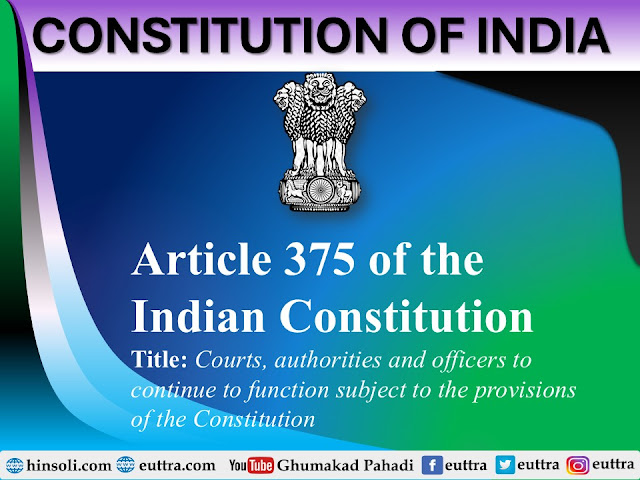 |
| What is Article 375 of Indian constitution |
Article 375 of the Indian Constitution
Title: Courts, authorities and officers to continue to function subject to the provisions of the Constitution
🔎 Simplified Summary:
| Aspect | Description |
|---|---|
| Purpose | Ensures continuity of all courts, authorities, and officers existing before the Constitution came into force (on 26 January 1950). |
| Key Provision | These courts and officials will continue to function but now under the framework of the new Constitution. |
| Condition | Their functioning is subject to the provisions of the Constitution, i.e., they must now follow constitutional limits and laws. |
| Nature | Transitional and enabling provision to avoid administrative or judicial disruption after independence. |
🏛️ Why It Was Needed:
When the Constitution came into force, India already had:
-
British-established courts (like High Courts),
-
Colonial officials and administrators, and
-
Various local authorities.
This article made sure:
-
These institutions did not stop working abruptly,
-
But would now work under India’s own Constitution.
✅ Example:
A District Collector or High Court Judge working under British law before 1950 continued in their role, but now operated under the Indian Constitution.
Here is a flowchart of Article 375 of the Indian Constitution, showing how it ensured the continuity of courts and officials after the Constitution came into force:
📊 Flowchart: Article 375 – Continuity of Courts, Authorities, and Officers
┌──────────────────────────────────────────────┐
│ Article 375: Continuity of Functioning │
│ of Courts, Authorities, and Officers │
└──────────────────────────────────────────────┘
│
▼
┌────────────────────────────────────────────┐
│ Before 26 Jan 1950: │
│ British-established courts & officials │
│ (e.g., District Collectors, Judges, etc.) │
└────────────────────────────────────────────┘
│
▼
┌────────────────────────────────────────────┐
│ 26 January 1950: Constitution of India │
│ comes into force │
└────────────────────────────────────────────┘
│
▼
┌────────────────────────────────────────────┐
│ Article 375: │
│ All existing courts, authorities, and │
│ officers to continue functioning │
└────────────────────────────────────────────┘
│
▼
┌────────────────────────────────────────────┐
│ BUT — They must now act │
│ **in accordance with the Constitution** │
│ (subject to its provisions) │
└────────────────────────────────────────────┘
│
▼
┌────────────────────────────────────────────┐
│ Ensures administrative and judicial │
│ **continuity and stability** post-independence│
└────────────────────────────────────────────┘
Here is a timeline of Article 375 of the Indian Constitution, showing how it played a key role in the smooth transition of power and administration after independence:
📅 Timeline: Article 375 – Continuation of Courts, Authorities & Officers
| Date / Period | Event |
|---|---|
| Before 1947 | India governed under British rule. Administrative posts (Collectors, Judges, etc.) and legal system (British-style courts) were already established. |
| 15 August 1947 | India gains independence. Existing British institutions continue under the Indian Independence Act, 1947. |
| 26 January 1950 | Constitution of India comes into effect. • Article 375 is enacted to ensure no disruption in functioning of courts, authorities, and officers. • All existing officials continue their roles, but now under the Constitution. |
| 1950s–Present | Over time, many officials are replaced through constitutional appointments, but Article 375 ensures legal and administrative continuity during early years. |
| Present Day | Article 375 remains in the Constitution, but as a historical transitional provision; its practical relevance has faded as the system is now fully constitutional. |
✅ Key Purpose:
To prevent administrative and judicial collapse by allowing British-era officials and systems to function until replaced or regularized under the Indian Constitution.
Here is a comparison of Article 375 with Article 374 and Article 376, as all three are part of the transitional provisions (Part XXI) and deal with continuity after independence:
📊 Comparison Chart: Article 374 vs 375 vs 376
| Feature / Aspect | Article 374 – Judges of Federal Court | Article 375 – Continuity of Authorities | Article 376 – Continuity of Judges |
|---|---|---|---|
| Focus | Transition of Federal Court judges to the Supreme Court | Continuation of all courts, authorities, and officers | Continuation of High Court Judges |
| Who it applies to? | Judges of the Federal Court (pre-1950) | All public functionaries (judicial, administrative, executive) | Judges of High Courts before Constitution |
| Purpose | Prevent disruption in Supreme Court setup | Prevent administrative and legal vacuum across India | Ensure judicial continuity in High Courts |
| Power of President | May allow or discontinue Federal Court Judges in SC | Not required to act directly | Can allow a pre-constitution judge to continue temporarily |
| Nature | Judicial transition from colonial to constitutional court | Administrative/judicial continuity across the board | Judicial continuity specific to High Courts |
| Scope | Specific to Supreme Court Judges from British era | Applies to all existing authorities and officials | Limited to pre-1950 High Court Judges |
| Duration | Transitional (used during 1950 SC formation) | Transitional (relevant mainly around 1950) | Transitional (till judges were reappointed under new system) |
| Current Status | Obsolete but part of Constitution | Obsolete but part of Constitution | Obsolete but part of Constitution |
✅ Summary:
-
Article 374 = Continuity of Federal Court Judges → Supreme Court.
-
Article 375 = Continuity of All authorities, officers, courts post-1950.
-
Article 376 = Continuity of High Court Judges under the new system.

.jpg)



















Follow Us